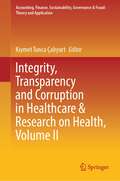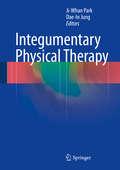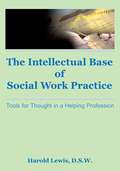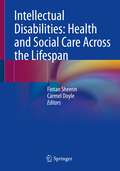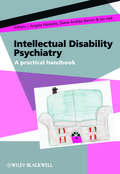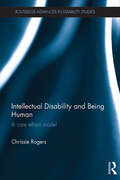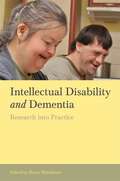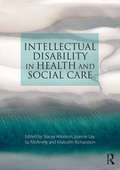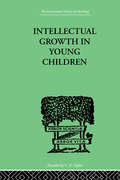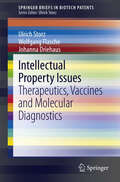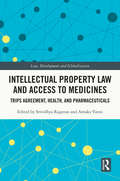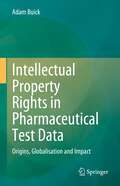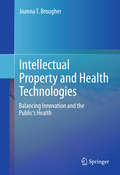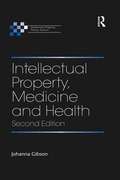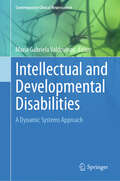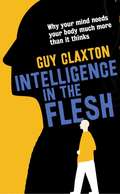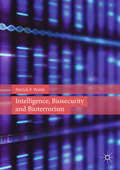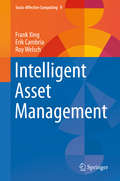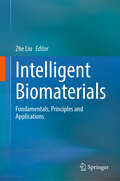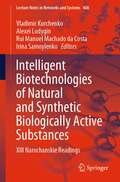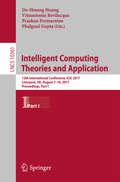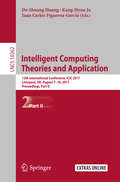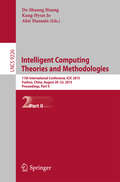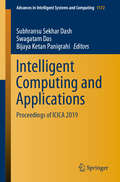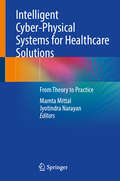- Table View
- List View
Integrity, Transparency and Corruption in Healthcare & Research on Health, Volume II (Accounting, Finance, Sustainability, Governance & Fraud: Theory and Application)
by Kıymet Tunca ÇalıyurtThis book continues the discussion from Volume I on the risks organizations face in order to succeed with a special focus on the challenges brought on by the COVID-19 virus crisis. Taking on an interdisciplinary focus, the book brings together research from academics and practitioners from all over the world. Topics considered range from corruption in the health sector and COVID-19, eHealth efforts of countries during the pandemic, and fiscal policies and transparency in data sharing for effective management of the pandemic to a path forward to achieve health for all.
Integumentary Physical Therapy
by Ji-Whan Park Dae-In JungThis book is a practical guide to safe and effective physical therapy methods that can be applied in patients with diverse skin ailments, including scars, decubitus ulcers, burns, frostbite, photosensitivity disorders, inflammatory skin disease, skin cancers, obesity-related conditions, psoriasis, herpes zoster, tineapedis, and vitiligo. For each condition, physical therapy interventions- therapeutic exercises, manual physical therapies, and therapeutic modalities employed in rehabilitation- are described in detail. In addition, information is provided on symptoms and complications, examination and evaluation, medical interventions, and prevention and management methods. In the case of obesity-related skin problems, management is discussed from the point of view of Eastern as well as Western medicine. The text is complemented by more than 300 color photographs and illustrations. Integumentary Physical Therapy will help the reader to obtain optimal therapeutic results when treating patients with skin ailments. It will be of value for both practicing physical therapists and students in physical therapy.
Intellectual Base of Social Work Practice: Tools for Thought in a Helping Profession
by Harold Lewis Jayne SilbermanThis much-needed exploration of the cognitive side of social work practice provides a framework for improving social work practice and education.
Intellectual Disabilities: Health and Social Care Across the Lifespan
by Fintan Sheerin Carmel DoyleThis textbook provides nurses, allied health and social care professionals with the background knowledge necessary to support individuals with intellectual disabilities and their families. It is a unique and viable resource which is particularly timely, as recent decades have seen a significant change in the demographics and associated care and support needs of this population. The textbook is laid into four sections to provide a logical structure for the content with chapters developing key topic areas relevant to the field. The introductory section sets the overall context for the book and considers the importance of developing an understanding of intellectual disability as a core concept identifying philosophies and models of service that underpin health and social care across the lifespan. Communication as a basis for caring and the overall concept of person-centred caring in a multidisciplinary context is considered. The second section explores key concepts from birth to adulthood exploring the nature of intellectual disability, the child with intellectual disability and other related neurodevelopmental conditions. The third section explores adulthood to older age and considers specific health care needs, understanding behaviour and other fundamental concepts including mental health, ageing and palliative care. The fourth and final section explores the integration of health and social care addressing such issues as supporting and enabling families, education, employment, and sexuality and relationships. Edited by experienced and widely respected professionals, this textbook is written by international practitioners, educators and researchers who all play critical roles in working with individuals with intellectual disability and their families.
Intellectual Disability Psychiatry
by Diana Andrea Barron Angela Hassiotis Ian HallIntellectual Disability Psychiatry is a comprehensive and accessible guide to the management of mental health problems in people with intellectual disabilities. A clear and user-friendly handbook, it will help busy healthcare professionals develop their understanding of the mental health problems of service users with intellectual disabilities. Most importantly, it will help them make an accurate diagnostic assessment and develop and implement an holistic, person-centred, evidence-based management plan.Topics covered include the classification of mental disorders in intellectual disability, the clinical assessment of specific disorders, psychological, psychopharmacological and social interventions, and the practical, legal, and social aspects of supporting service users with intellectual disability who have mental health problems.
Intellectual Disability and Being Human: A Care Ethics Model (Routledge Advances in Disability Studies)
by Chrissie RogersIntellectual disability is often overlooked within mainstream disability studies, and theories developed about disability and physical impairment may not always be appropriate when thinking about intellectual (or learning) disability. This pioneering book, in considering intellectually disabled people's lives, sets out a care ethics model of disability that outlines the emotional caring sphere, where love and care are psycho-socially questioned, the practical caring sphere, where day-to-day care is carried out, and the socio-political caring sphere, where social intolerance and aversion to difficult differences are addressed. It does so by discussing issue-based everyday life, such as family, relationships, media representations and education, in an evocative and creative manner. This book draws from an understanding of how intellectual disability is represented in all forms of media, a feminist ethics of care, and capabilities, as well as other theories, to provide a critique and alternative to the social model of disability as well as illuminate care-less spaces that inhabit all the caring spheres. The first two chapters of the book provide an overview of intellectual disability, the debates surrounding disability, and outline the model. Having begun to develop an innovative theoretical framework for understanding intellectual disability and being human, the book then moves onto empirical and narrative driven issue-based chapters. The following chapters build on the emergent framework and discuss the application of particular theories in three different substantive areas: education, mothering and sexual politics. The concluding remarks draw together the common themes across the applied chapters and link them to the overarching theoretical framework. An important read for all those studying and researching intellectual or learning disability, this book will be an essential resource in sociology, philosophy, criminology (law), social work, education and nursing in particular.
Intellectual Disability and Dementia: Research into Practice
by David Thompson Philip Mccallion Irene Tuffrey-Wijne Heather Wilkinson Chris Bigby Noelle Blackman Michael Splaine Liam Wilson Shahid H. Zaman Karen Watchman Evelyn Reilly Niamh Mulryan Moni Grizzell Antonia Mw Coppus Matthew P Janicki Tony Holland Andre Strydom Karen Dodd Mary Mccarron Rachel Carling Jenkins Teresa Iacono Sunny Kalsy Trevor Chan Ken Courtenay Nicolle Eady Amanda Sinai Nancy Jokinen Susan Benbow Leslie Udell Tiina Annus Andrew GriffithPresenting the most up-to-date information available about dementia and intellectual disabilities, this book brings together the latest international research and evidence-based practice, and describes clearly the relevance and implications for support and services Internationally renowned experts from the UK, Ireland, the USA, Canada, Australia and the Netherlands discuss good practice and the way forward in relation to assessment, diagnosis, interventions, staff knowledge and training, care pathways, service design, measuring outcomes and the experiences of individuals, families and carers. The wealth of information offered will inform support and services throughout the whole course of dementia, from diagnosis to end of life. Particular emphasis is placed on how intellectual disability and dementia services can work collaboratively to offer more effective, joined up support. Practitioners, managers and commissioners will find this to be an informative resource for developing person-centred provision for people with intellectual disabilities and dementia and their families. It will also be a key text for academics and students who wish to be up-to-date with the latest research and practice developments in this field.
Intellectual Disability in Health and Social Care
by Stacey Atkinson Joanne Lay Su McAnelly Malcolm RichardsonMany practitioners within health and social care come into contact with people with intellectual disabilities and want to work in ways that are beneficial to them by making reasonable adjustments in order to meet clients’ needs and expectations. Yet the health and wellbeing of people with learning disabilities continues to be a neglected area, where unnecessary suffering and premature deaths continue to prevail. This text provides a comprehensive insight into intellectual disability healthcare. It is aimed at those who are training in the field of intellectual disability nursing and also untrained practitioners who work in both health and social care settings. Divided into five sections, it explores how a wide range of biological, health, psychological and social barriers impact upon people with learning disability, and includes: Six guiding principles used to adjust, plan and develop meaningful and accessible health and social services Assessment, screening and diagnosis of intellectual disability across the life course Addressing lifelong health needs Psychological and psychotherapeutic issues, including sexuality, behavioural and mental health needs, bereavement, and ethical concerns. The changing professional roles and models of meeting the needs of people with intellectual and learning disabilities. Intellectual Disability in Health and Social Care provides a wide-ranging overview of what learning disability professionals’ roles are and provides insight into what health and social care practitioners might do to assist someone with intellectual disabilities when specific needs arise.
Intellectual Growth In Young Children: With an Appendix on Children's "Why" Questions by Nathan Isaacs
by Isaacs, SusanRoutledge is now re-issuing this prestigious series of 204 volumes originally published between 1910 and 1965. The titles include works by key figures such asC.G. Jung, Sigmund Freud, Jean Piaget, Otto Rank, James Hillman, Erich Fromm, Karen Horney and Susan Isaacs. Each volume is available on its own, as part of a themed mini-set, or as part of a specially-priced 204-volume set. A brochure listing each title in the "International Library of Psychology" series is available upon request.
Intellectual Property Issues
by Ulrich Storz Johanna Driehaus Wolfgang FlascheSpringerBriefs in Biotech Patents present timely reports of intellectual properties (IP) issues and patent aspects in the field of biotechnology. This new volume in the series focuses on the particular IP issues of therapeutics, vaccines and molecular diagnostics. The first chapter concentrates on basics principles for protecting antibody compounds. Additional ways to create follow-up protection for antibody therapeutics are also discussed. The second chapter gives an overview of the patent landscape in molecular diagnostics, and discusses issues of patentability with respect to the different technologies and compounds used therein. The third chapter gives a broad overview of areas of law that are particularly relevant to the patenting of peptide vaccines and therapeutic peptides as products and in compositions. The scope of patentable subject matter is discussed, as it has been the focus of much wrangling and debate in the courts.
Intellectual Property Law and Access to Medicines: TRIPS Agreement, Health, and Pharmaceuticals (Law, Development and Globalization)
by Srividhya RagavanThe history of patent harmonization is a story of dynamic actors, whose interactions with established structures shaped the patent regime. From the inception of the trade regime to include intellectual property (IP) rights to the present, this book documents the role of different sets of actors – states, transnational business corporations, or civil society groups – and their influence on the structures – such as national and international agreements, organizations, and private entities – that have caused changes to healthcare and access to medication. Presenting the debates over patents, trade, and the Agreement on Trade-Related Aspects of Intellectual Property Rights (TRIPS Agreement), as it galvanized non-state and nonbusiness actors, the book highlights how an alternative framing and understanding of pharmaceutical patent rights emerged: as a public issue, instead of a trade or IP issue. The book thus offers an important analysis of the legal and political dynamics through which the contest for access to lifesaving medication has been, and will continue to be, fought. In addition to academics working in the areas of international law, development, and public health, this book will also be of interest to policy makers, state actors, and others with relevant concerns working in nongovernmental and international organizations.
Intellectual Property Rights in Pharmaceutical Test Data: Origins, Globalisation and Impact
by Adam BuickThis book considers the intellectual property protection of clinical test data that has been submitted to governments, in particular through test data exclusivity rights. It focuses on how these intellectual property rights first emerged in the early 1980s, how they have globalised over the past four decades, and what impact they have had upon access to medicine. This book makes a number of significant and original contributions to the literature around the protection of submitted test data. First, the book draws upon the theory of regulatory globalisation to provide an explanation of how intellectual property rights in submitted pharmaceutical test data have become nearly ubiquitous in the legal systems of most major economies. Second, through a comprehensive analysis and synthesis of provisions on the protection of submitted test data in free trade agreements, as well as a comparison of a range of national approaches to the protection of submitted test data, it reveals the broader global regulatory pattern that has given rise to these intellectual property rights. Third, by analysing data on drug approvals in the US, it provides an empirical insight into the impact of test data exclusivity in national pharmaceutical markets. Fourth, the book covers a number of developments regarding test data exclusivity that have occurred as a result of responses to the COVID-19 pandemic, both at the national level as well as at the World Trade Organisation (WTO). This book will appeal to academics researching the intersection of intellectual property and the life sciences, civil society activists working to promote access to medicines, and students (particularly those at the post-graduate level) studying the relationship between intellectual property and medicine.
Intellectual Property and Health Technologies
by Joanna T. BrougherIntellectual Property and Health Technologies Balancing Innovation and the Public's Health Joanna T. Brougher, Esq. , MPH At first glance, ownership of intellectual property seems straightforward: the control over an invention or idea. But with the recent explosion of new scientific discoveries poised to transform public health and healthcare systems, costly and lengthy patent disputes threaten both to undermine the attempts to develop new medical technologies and to keep potentially life-saving treatments from patients who need them. Intellectual Property and Health Technologies grounds readers in patent law and explores how scientific research and enterprise are evolving in response. Geared specifically to the medical disciplines, it differentiates among forms of legal protection for inventors such as copyrights and patents, explains their limits, and argues for balance between competing forces of exclusivity and availability. Chapters delve into the major legal controversies concerning medical and biotechnologies in terms of pricing, markets, and especially the tension between innovation and access, including: The patent-eligibility of genes The patent-eligibility of medical process patents The rights and roles of universities and inventors The balancing of access, innovation, and profit in drug development The tension between biologics, small-molecule drugs, and their generic counterparts International patent law and access to medicine in the developing world As these issues continue to shape and define the debate, Intellectual Property and Health Technologies enables professionals and graduate students in public health, health policy, healthcare administration, and medicine to understand patent law and how it affects the development of medical technology and the delivery of medicine.
Intellectual Property, Medicine and Health: Current Debates (Intellectual Property, Theory, Culture Ser.)
by Johanna GibsonIntellectual Property, Medicine and Health examines critical issues and debates, including access to knowledge and medicinal products, human rights and development, innovations in life technologies and the possibility for ethical frameworks for intellectual property law and its application in public health. The second edition accounts for recent and in some areas extensive developments in this dynamic and fast-moving field. This edition brings together new and updated examples and analysis in competition and regulation, gene-related inventions and biotechnology, as well as significant cases, including Novartis v Union of India.
Intellectual and Developmental Disabilities: A Dynamic Systems Approach (Contemporary Clinical Neuroscience)
by Maria Gabriela ValdovinosThis new reference provides a comprehensive overview of intellectual and developmental disabilities, incorporating multiple perspectives and disciplines (including developmental neuroscience, genetics, psychiatry, and psychology) with a multifaceted approach, offering readers appreciation for the richness of the population and field. It provides readers with an understanding of the developmental, biological, and behavioral aspects of developmental disabilities with the aim of understanding their causes, the differences between disabilities, and familiarity with the prognosis and developmental outcomes for children diagnosed with various developmental disabilities.
Intelligence in the Flesh
by Guy ClaxtonIf you think that intelligence emanates from the mind and that reasoning necessitates the suppression of emotion, you'd better think again--or rather not "think" at all. In his provocative new book, Guy Claxton draws on the latest findings in neuroscience and psychology to reveal how our bodies--long dismissed as mere conveyances--actually constitute the core of our intelligent life. From the endocrinal means by which our organs communicate to the instantaneous decision-making prompted by external phenomena, our bodies are able to perform intelligent computations that we either overlook or wrongly attribute to our brains. Embodied intelligence is one of the most exciting areas in contemporary philosophy and neuropsychology, and Claxton shows how the privilege given to cerebral thinking has taken a toll on modern society, resulting in too much screen time, the diminishment of skilled craftsmanship, and an overvaluing of white-collar over blue-collar labor. Discussing techniques that will help us reconnect with our bodies, Claxton shows how an appreciation of the body's intelligence will enrich all our lives.
Intelligence, Biosecurity and Bioterrorism
by Patrick F. WalshThis book explores how potential bio-threats and risks may evolve post 9/11 given the rapid changes in biotechnology and synthetic biology. It also explores what role intelligence communities can play in understanding threats and risks. It argues that although bio-threats and risks are largely low probability and high impact in nature, intelligence in ‘Five Eyes’ countries remain insufficiently prepared to understand them. This book identifies key areas where intelligence reforms need to take place including a more strategic and systematic collaboration between national security/law enforcement intelligence and the scientific community. It is aimed at intelligence analysts, those in the scientific community working on health security threats, policy makers and researchers working on biosecurity and bioterrorism threats and risks.
Intelligent Asset Management (Socio-Affective Computing #9)
by Erik Cambria Frank Xing Roy WelschThis book presents a systematic application of recent advances in artificial intelligence (AI) to the problem of asset management. While natural language processing and text mining techniques, such as semantic representation, sentiment analysis, entity extraction, commonsense reasoning, and fact checking have been evolving for decades, finance theories have not yet fully considered and adapted to these ideas.In this unique, readable volume, the authors discuss integrating textual knowledge and market sentiment step-by-step, offering readers new insights into the most popular portfolio optimization theories: the Markowitz model and the Black-Litterman model. The authors also provide valuable visions of how AI technology-based infrastructures could cut the cost of and automate wealth management procedures.This inspiring book is a must-read for researchers and bankers interested in cutting-edge AI applications in finance.
Intelligent Biomaterials: Fundamentals, Principles and Applications
by Zhe LiuThis book presents the latest advances in intelligent biomaterials, a fast developing area for disease diagnosis and treatments, health management and rehabilitations. In particular, this book focuses on versatile types of emerging intelligent biomaterials as well as their multiple roles in smart biosensors, tissue engineering, medical meta-data analysis, micro/nanorobotics and artificial intelligence-based theranostics. These state-of-the-art technologies and updated knowledge are expected to reshape the future trend of biomaterials, and more importantly integrate biomaterials and intelligence together as a single entity to serve human health improvements. On this basis, this book aims to elucidate the concept and domain of intelligent biomaterials, and discuss on their cutting-edge applications. It will provide a vast readership, including students, scientists, researchers and professional staff in the trans-disciplinary community, with a brand-new viewpoint to learn about the frontiers of intelligent biomaterials.
Intelligent Biotechnologies of Natural and Synthetic Biologically Active Substances: XIII Narochanskie Readings (Lecture Notes in Networks and Systems #408)
by Vladimir Kurchenko Alexei Lodygin Rui Manuel Machado da Costa Irina SamoylenkoThis book contains articles on innovative biotechnologies for the production and application of biopolymers and their derivatives in various industries. The conference “Intelligent Biotechnologies of Natural and Synthetic Biologically Active Substances: XIII Narochanskie Readings” took place on the base of Belarussian State University (Republic of Belarus, Minsk) and North Caucasus Federal University (Russian Federation, Stavropol) on December 1–3, 2021.The general scope of the book is current issues of biologically active substances (BAS) recovery and preparation methods development and their application in medicine, pharmaceutics, and functional nutrition.A number of original articles are devoted to the actual problems of BAS obtaining and application. A significant part of articles is related to the production of BAS nanocomplexes.Much attention is paid to promising areas of healthy foods biotechnology development and food safety. The book intends to readership specializing in the field of searching for new sources of BAS for their practical use in the framework of innovative pharmaceuticals and functional foods development
Intelligent Computing Theories and Application
by Phalguni Gupta Prashan Premaratne De-Shuang Huang Vitoantonio BevilacquaThe International Conference on Intelligent Computing (ICIC) was formed to provide an annual forum dedicated to the emerging and challenging topics in artificial intel- gence, machine learning, pattern recognition, image processing, bioinformatics, and computational biology. It aims to bring together researchers and practitioners from both academia and industry to share ideas, problems, and solutions related to the m- tifaceted aspects of intelligent computing. ICIC 2010, held in Changsha, China, August 18-21, 2010, constituted the 6th - ternational Conference on Intelligent Computing. It built upon the success of ICIC 2009, ICIC 2008, ICIC 2007, ICIC 2006, and ICIC 2005, that were held in Ulsan, Korea, Shanghai, Qingdao, Kunming and Hefei, China, respectively. This year, the conference concentrated mainly on the theories and methodologies as well as the emerging applications of intelligent computing. Its aim was to unify the picture of contemporary intelligent computing techniques as an integral concept that highlights the trends in advanced computational intelligence and bridges theoretical research with applications. Therefore, the theme for this conference was "Advanced Intelligent Computing Technology and Applications. " Papers focusing on this theme were solicited, addressing theories, methodologies, and applications in science and technology.
Intelligent Computing Theories and Application
by De-Shuang Huang Kang-Hyun Jo Juan Carlos Figueroa-GarcíaThe International Conference on Intelligent Computing (ICIC) was formed to provide an annual forum dedicated to the emerging and challenging topics in artificial intel- gence, machine learning, pattern recognition, image processing, bioinformatics, and computational biology. It aims to bring together researchers and practitioners from both academia and industry to share ideas, problems, and solutions related to the m- tifaceted aspects of intelligent computing. ICIC 2010, held in Changsha, China, August 18-21, 2010, constituted the 6th - ternational Conference on Intelligent Computing. It built upon the success of ICIC 2009, ICIC 2008, ICIC 2007, ICIC 2006, and ICIC 2005, that were held in Ulsan, Korea, Shanghai, Qingdao, Kunming and Hefei, China, respectively. This year, the conference concentrated mainly on the theories and methodologies as well as the emerging applications of intelligent computing. Its aim was to unify the picture of contemporary intelligent computing techniques as an integral concept that highlights the trends in advanced computational intelligence and bridges theoretical research with applications. Therefore, the theme for this conference was "Advanced Intelligent Computing Technology and Applications. " Papers focusing on this theme were solicited, addressing theories, methodologies, and applications in science and technology.
Intelligent Computing Theories and Methodologies
by De-Shuang Huang Kang-Hyun Jo Abir HussainThis two-volume set LNCS 9225 and LNCS 9226 constitutes - in conjunction with the volume LNAI 9227 - the refereed proceedings of the 11th International Conference on Intelligent Computing, ICIC 2015, held in Fuzhou, China, in August 2015. The total of 191 full and 42 short papers presented in the three ICIC 2015 volumes was carefully reviewed and selected from 671 submissions. The papers are organized in topical sections such as evolutionary computation and learning; compressed sensing, sparse coding and social computing; neural networks, nature inspired computing and optimization; pattern recognition and signal processing; image processing; biomedical informatics theory and methods; differential evolution, particle swarm optimization and niche technology; intelligent computing and knowledge discovery and data mining; soft computing and machine learning; computational biology, protein structure and function prediction; genetic algorithms; artificial bee colony algorithms; swarm intelligence and optimization; social computing; information security; virtual reality and human-computer interaction; healthcare informatics theory and methods; unsupervised learning; collective intelligence; intelligent computing in robotics; intelligent computing in communication networks; intelligent control and automation; intelligent data analysis and prediction; gene expression array analysis; gene regulation modeling and analysis; protein-protein interaction prediction; biology inspired computing and optimization; analysis and visualization of large biological data sets; motif detection; biomarker discovery; modeling; simulation; and optimization of biological systems; biomedical data modeling and mining; intelligent computing in biomedical signal/image analysis; intelligent computing in brain imaging; neuroinformatics; cheminformatics; intelligent computing in computational biology; computational genomics; special session on biomedical data integration and mining in the era of big data; special session on big data analytics; special session on artificial intelligence for ambient assisted living; and special session on swarm intelligence with discrete dynamics.
Intelligent Computing and Applications: Proceedings of ICICA 2019 (Advances in Intelligent Systems and Computing #1172)
by Bijaya Ketan Panigrahi Swagatam Das Subhransu Sekhar DashThis book presents the peer-reviewed proceedings of the 5th International Conference on Intelligent Computing and Applications (ICICA 2019), held in Ghaziabad, India, on December 6–8, 2019. The contributions reflect the latest research on advanced computational methodologies such as neural networks, fuzzy systems, evolutionary algorithms, hybrid intelligent systems, uncertain reasoning techniques, and other machine learning methods and their applications to decision-making and problem-solving in mobile and wireless communication networks.
Intelligent Cyber-Physical Systems for Healthcare Solutions: From Theory to Practice
by Mamta Mittal Jyotindra NarayanThis book widens the insights with the advent of data-driven techniques using intelligent Cyber-Physical Systems to monitor and diagnose patients, provide personalized treatments, and enhance the overall quality of care. Intelligent Cyber-Physical Systems for healthcare solutions is an emerging area of research that aims to integrate advanced technologies, such as sensors, actuators, artificial intelligence, and the Internet of things, with healthcare systems to improve patient outcomes. This book provides an overview of the state-of-the-art in this field, showcasing the latest advances in cyber-physical systems design and implementation—the challenges and opportunities in applying CPS to healthcare. The book covers various aspects of intelligent cyber-physical systems in healthcare, including architecture, communication protocols, data processing, monitoring, diagnosis, rehabilitation, and assistive technologies. It also addresses important issues such as security, privacy, and ethics considerations and presents best practices for ensuring the safety and reliability of CPS in healthcare. The book offers a valuable resource for researchers, practitioners, and students to transform healthcare and improve patient outcomes while highlighting the need for interdisciplinary collaboration and ethical considerations in its design and implementation.
